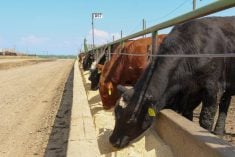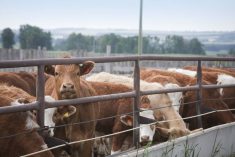Alberta packers were buying fed cattle on a dressed basis in the range of $425-$428/cwt delivered in mid-August.
Live prices were quoted at $255/cwt (US$186), f.o.b. feedlot, in southern Alberta. The fed market has come off the summer highs as demand eases moving into the fall period. Monthly restaurant spending on both sides of the border has decreased after making seasonal highs in June. Economic growth in Canada and the U.S. is expected to stall later in fall.
The jobless rate is expected to increase and consumer spending is expected to decrease in both Canada and the U.S. I follow many analysts and they all focus on cattle and beef supplies. When I started writing cattle market analysis 25 years ago, an old-timer told me that if one wanted to be successful as a cattle analyst, you have to focus on the economy and consumer spending for the average American.
Read Also

Gentle treatments for pain in the neck
Heading toward year-end, people unknowingly tense up against the cold and busyness, causing neck pain that can often be treated with appropriate support and gentle mobility, athletic therapist Kathlyn Hossack says.
This was the best advice I ever received. Focusing on the discretionary spending of the average American consumer defines long-term trends in the cattle market.
The cattle market is vulnerable to softer economic growth. During July, Canadian employers shed 2,100 positions. This follows the elimination of 41,000 full-time jobs in the second quarter. In the U.S., job growth totalled 114,000 jobs in July but this is down from the 12-month average of 225,000 positions. The unemployment rate in Canada and the U.S. is expected to increase over the next six to 12 months.
The U.S. Federal Reserve held its benchmark rate at 5.5 per cent at its meeting on July 31. The Fed rate had been at this level since July 2023. Expectations are that the U.S. central bank will lower its interest rate by 25 basis points on Sept. 18. This will likely be followed by another cut in November or December.
The Bank of Canada cut its policy rate by 25 basis points on June 5 and then again on July 24. The financial industry is expecting two additional rate cuts from the Bank of Canada in 2024. [Editor’s note: this column was written before both the Bank of Canada’s Sept. 4 rate cut to 4.25 per cent and the U.S. Fed’s Sept. 18 rate cut to 4.75-5.00 per cent.]
If we look at past history, the unemployment rate will continue to increase as the central banks lower interest rates. It takes 12 to 18 months for interest rate adjustments to work through the economy. U.S. and Canadian consumers have cut back on spending due to elevated inflation and higher interest rates, which have been in place for a couple of years. In the U.S. McDonald’s same-store sales decreased 0.7 per cent in the second quarter. Last year, same-store sales were up 10 per cent. This is a leading indicator for consumer financial health and the overall economy.
I want to discuss two examples from past history. The Federal Reserve’s (Fed) policy rate peaked in June 1981 at 19.1 per cent and the unemployment rate was at 7.6 per cent. During the major recession of 1982, gross domestic product (GDP) was negative each quarter. Unemployment actually peaked in December 1982 at 10.8 per cent, at which time the Fed funds rate was at nine per cent. The unemployment rate increased and the Fed decreased its policy rate.
In July 2007, the Federal Reserve’s rate was at 5.26 per cent, which was the high prior to the recession. At the same time, unemployment was at 4.7 per cent. The main recession occurred from the fourth quarter of 2008 to the first quarter of 2009. In October 2008, the Fed lowered its policy rate to zero to 0.25 per cent. Unemployment peaked at 10 per cent in November 2009.
Again, the unemployment rate increased and the Fed decreased its policy rate. In both of these cases, the fed cattle market dropped by 20 per cent and a similar decrease was noted in feeder cattle prices. Again, there is a time lag of three to four months for the feeder market, but keep this in the back of your mind.
There is another factor to consider: the U.S. beef cow slaughter during June was 227,000 head, the lowest since July 2017. During 2017, the U.S. cattle herd was expanding. This may be the first signal that the U.S. cattle herd is moving into an expansionary phase. This is also very timely.
Throughout history, the U.S. cattle producer expands the herd when U.S. interest rates are at the roof. Back to my first example, the U.S. cattle producer started to expand the herd in 1981 at which time the U.S. economy was transitioning into a recession. The cow-calf producer is a perfect indicator to time when the cattle market turns from an upward trend to a downward trend.
During August, Alberta yearling steers averaging 1,000 lbs. off pasture were trading for $330/cwt. These steers have a break-even price in December around $275/cwt. This is $20/cwt above current levels. Feedlot margins will move into negative territory during October 2024. The fed and feeder markets are expected to trend lower from October 2024 through December 2025.
















